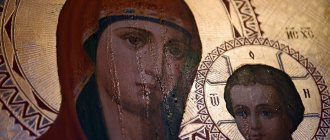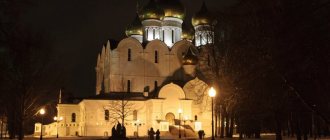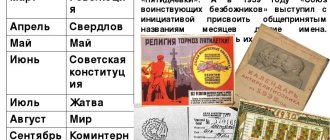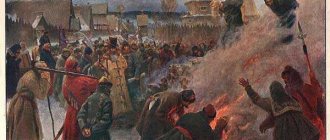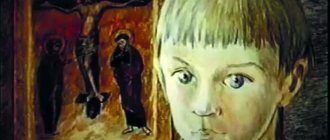The summer of 7527 from the creation of the world is not a fictitious date. This year ended on December 31, 2021. Over time, historical games led to the fact that almost five thousand years fell out of the chronology.
Modern chronology is calculated from the Nativity of Christ. Moreover, it is conducted equally carefully by both Catholics and Orthodox. The chronology system has been repeatedly changed and modernized. Didn't humanity lose several tens or hundreds of years in the same way as the Bolsheviks lost 13 calendar days?
Time through the eyes of the ancients
Egyptian calendar based on the floods of the Nile
The first question that arises in your head when you hear about the seventh millennium is: why the seventh? How did people establish that the world was “created” exactly 7527 years ago? It should be noted that ancient people did not think in modern terms at all.
For primitive tribes, time seemed like chaos. That is, life was divided into unequal segments, the boundaries of which were natural phenomena. The year could end with the first snow or the first lightning strike. The Egyptians, Greeks and Assyrians compared time with the reign of kings. In addition, ancient and ancient people thought of time as a looped spiral.
Each civilization had its own calendar. The Romans, for example, compiled the first calendar in the 7th century BC. At first, there were seven months, which were calculated by the movement of the moon. The astronomer Numa Pompilius recalculated the number of days and added two more months.
What did Christians think?
The first major calendar reform was carried out under Julius Caesar. He declared the beginning of the countdown to be 46 BC. In the 4th century, all Christians obediently accepted the Julian counting of years. However, a century later the years were counted again.
This was done by the monk Dionysius the Small by order of Pope John I. The abbot, who was compiling Easter tables, approximately calculated the date of birth of Jesus Christ. Based on the information contained in the Gospel of Luke, he told the pope the exact date.
Historians are convinced that Dionysius made a mistake in his calculations. As a result, his calendar was “in a hurry” for several years.
Nugget named Trouble
Bede, or Bede (the emphasis in this Old English name is on the first syllable), was born in 673, into the family of an ordinary English peasant who lived in a village called Monkton. However, his father, apparently, was quite a wealthy man. At least he could afford not to put his son to work in the fields, but to send him to the nearby Wearmouth monastery to learn to read and write. The seven-year-old boy turned out to be very capable of learning. He himself later said that more than anything in the world he loved “to study, teach and write.”
In 681, a “daughter” monastery of Wearmouth was founded, called Jarrow. Bede moved there, accompanying his teacher, the monk Ceolfrith. And he spent the rest of his life within the walls of this monastery, until his death in 735 at the age of 62.
The life of medieval monks was not easy. Each monastery had peasants who provided it with everything necessary, but, according to the charter of St. Benedict, the monks themselves were obliged to work tirelessly: some in the field, and some in the scriptorium, the hall where books were copied and decorated. It was there that Bede had his workplace, who quickly became famous for his excellent memory, keen mind and precise hand. All this made him an ideal copyist and commentator on books. First of all, the Bible, to the study of which he devoted his whole life.
Meanwhile, ordinary medieval life was going on around. And a few years later, the monastery was affected by the plague epidemic that struck Northumbria. Of the entire Jarrow monastery, only 2 people survived: Bede and Abbot Ceolfrith. But everyday difficulties did not in the least break the character of the monk, who strived for knowledge.
The final reform of Peter I
The chronology developed by Dionysius began to be used only two centuries later. In the 9th century, European royal documents already used a new chronology.
It's hard to believe, but Russia followed the Byzantine calendars until the 17th century. The chronology was carried out not from the birth of Christ, but from the creation of the world. Thus, the year 1699 in Russia was 7208. Peter I, who followed Europe, decided for convenience to modernize the calendar in a Western manner.
After 7208, the year 1700 came in Russia. By the way, it did not come in September, as was customary before. The start of the year was moved to January. Perhaps Peter I followed Roman traditions. Under Julius Caesar, the year began in January (“January” - Julius), since it was in this month that new politicians and statesmen were elected.
Mayan civilization calendar
How Russia switched to a new chronology
On December 29, 1699, Peter I issued a Decree on the transition to chronology from the Nativity of Christ instead of the previously celebrated “from the creation of the world.” The rejection of archaic chronology became, among other things, an additional spiritual basis for the radical reforms planned by the tsar in the social life and state structure of Russia - after all, there was a symbolic rejection of the Byzantine tradition in favor of the Western tradition dominant in the Christian world.
The personal Decree No. 1735 itself was issued by the Tsar shortly after returning from a trip to Europe as part of the “Grand Embassy”. Whose main goal was, of course, not just for its participants to gain new impressions, like modern tourists, but the desire of the young autocrat to adopt there what he considered best and necessary for transfer to Russian soil. After all, earlier Peter drew his impressions of Western life only from what he saw in the “German Settlement” near Moscow, a kind of “ghetto” for foreigners living in the Muscovite kingdom. But it is clear that forming an adequate impression of the peculiarities of Western life from the experience of only a small enclave is a very difficult task. The Decree itself was quite brief.
“In the Order and in all orders in notes, notes, in letters and in all our great sovereign decrees on all sorts of matters, and in orders, and in squares in all fortresses and in cities, to governors in lists, and in notes, and in estimates and note lists, and in all official and worldly affairs of the summer, write and count the years of January from the 1st day of 7208 and count this from the Nativity of the Lord God and our Savior Jesus Christ in 1700, and a year later in January from the 1st day of the year before 7209 write from the Nativity of Christ January from the 1st day of 1701 and in the future ones to be repaired according to the same, and from that new year January months and other months and dates to be written in a row until January and in other years, counting the years from the Nativity of Christ according to the same" By the way, this document was and far from being as categorical as many other initiatives of the autocrat-reformer. Since he allowed those who wished to inscribe dates twice - both according to the new order and according to the old order, from the creation of the world. Although, it is possible that such liberalism, uncharacteristic of Peter, in reform issues was dictated by purely pragmatic considerations - the understanding that with double writing of dates, people would begin to compare them correctly much faster and, in the end, the chronology from the Nativity of Christ would become just as familiar to them , just like before. Another interesting detail - the Decree on changing the chronology did not contain any clear justification for the innovation. This justification indirectly appeared in another Decree of Peter the Great - on the beginning of the New Year celebration from January 1 instead of September 1, as was previously the case in Rus'.
“He became known to the great sovereign, not only in many European Christian countries, but also among the Slovenian peoples, who agree with our Eastern Orthodox Church in everything, such as: Volokhi, Moldavians, Serbs, Dolmatians, Bulgarians, and even his great sovereign’s subjects Cherkasy and all the Greeks, from whom our Orthodox faith was adopted, all those peoples, according to their years, count their years from the Nativity of Christ on the eighth day later, that is, January from the 1st day, and not from the creation of the world, for many discords and counting in those years, and now the year from the Nativity of Christ reaches 1699, and next January, from the 1st day, the new year 1700 begins, together with a new century of centuries; and for this good and useful deed, he indicated that from now on the summers should be counted in orders, and in all matters and fortresses to be written from this January from the 1st of the Nativity of Christ 1700.”
***
In fact, of course, the notorious “discord” mentioned by Peter as an important reason for the introduction of a new chronology was not so relevant by the end of the 17th century. That is, yes, then yes - this very “creation of the world” by God in different traditions (including among completely Christian churches) really did not differ in ideal chronological unification. Well, for example, here is a fairly indicative list of “inconsistencies” in calculating the exact date of the creation of the world by God according to the systems of different Orthodox churches in the East. Alexandria - August 29, 5493 BC. e. Antiochian era - September 1, 5500 Old Byzantine era - 5504 BC e. Ninefold era - 5509 BC. e. Decimal Era - 5510 BC e. Eleventh era - 5511 BC. e. As you can see, the difference in the “zero” date reaches 18 years! That is, when people who adhere to these different systems communicate, it is quite possible for misunderstandings to arise, which can lead to unpleasant consequences. But in addition to the date of the creation of the world about 5.5 thousand years BC, calculated on the basis of the translation of the Bible by “72 interpreters” from among the Jewish sages, made for one of the heirs of Alexander the Great, there was a date based on the translation made by the famous father of the Western Church St. Jerome of Stridon at the turn of the 4th and 5th centuries AD, the so-called “Vulgate”. According to the latter, the world was created more than a thousand years later!
***
However, by the end of the 17th century, the discrepancies described above were more the property of learned theologians and historians. The vast majority of ordinary Orthodox Christians knew only about one date for the “creation of the world” - 5509 BC, also known as the “Constantinople era”. The trouble was that Constantinople by that time had already been conquered by the Ottoman Turks for almost two and a half centuries and became the capital of the Ottoman Porte with Islam as the state religion. And the former Byzantine patriarchs eked out a rather miserable existence at the Sultan’s court as “ethnarchs” - the formal leaders of the ethnic Orthodox Greek-Romans. More like the role of classic “whipping boys” in the event that the Ottoman autocrats deigned to be angry with non-Muslims for some of their “sins” from the point of view of the “titular nation” of the Porte. Russia, which by that time had become the only fully independent Orthodox country, of course, did not want to put up with ecclesiastical subordination to the actual puppets of the Turkish Sultan. At first, the formal reason for refusing the patronage of Constantinople was the latter’s signing of the Union of Florence of 1437, in which the Byzantine hierarchs agreed to renounce many positions in the dispute with the Catholics, and later in Moscow they simply did not want any dependence of their own Orthodox hierarchy on “Turkish subjects.” During this period, the theory of “Moscow - the Third Rome” appeared; at the end of the 16th century, Rus' received its own patriarchate; in the middle of the 17th century, an attempt began to transform the Muscovite kingdom into the “hegemon” of the entire Orthodox world. For which, in fact, the “Nikon” reforms were launched, alas, they ended in the most significant split of Russian Orthodoxy into supporters of the “new” and “old” faith.
***
However, the reign of Peter marked the beginning of even more significant reforms - already in a Western manner. Simply because the gap between the East and the West became more and more noticeable, as they say, with the naked eye. Even the most educated Orthodox Greeks, Syrians, and Egyptians could only give Russia considerable knowledge of the thousand-year-old spiritual traditions of Orthodoxy, but, alas, not even the truly outstanding technical culture of the lost Byzantium. And the “locomotive” of the most modern achievements in the economy, industry, and science at that time became Western Europe, in which predominantly Catholics and Protestants “ruled the show.” Of course, Pyotr Alekseevich was not going to radically abandon the Orthodox spiritual roots of Rus' in the spirit of modern Western liberals. If only because the rejection of any spiritual exclusivity or identity inevitably leads to the question: why does such a state exist at all? Well, for example, the desire of independent Ukraine to become either a “second France” or a “second Poland” (or even Finland - as long as the salaries were higher) led to the actual status of a “failed state”. Or as the Kiev “Maidan” philosopher Datsyuk self-critically noted: “We are not talking about a “failed state”, not about a failed, erroneous state, which Putin himself is talking about. We are talking about a “disgrace state”, a state of humiliation, a shameful state. Which cannot even realize that it is falling apart, and pretends that it continues to exist.”
Of course, the tsar-reformer did not intend to turn “Moscow - the Third Rome” into a “second France” (or Peter’s especially beloved Holland), preferring to limit himself to only a “pro-Western modification” of his state, but with the obligatory preservation of its identity. But taking into account the fact that opponents of the reforms relied primarily on the “grandfather’s traditions,” the crown bearer tried to reduce their veneration, which often turned into a real cult. All these “all-joking councils” of Peter’s drunken comrades-in-arms, as a parody of church or even state councils, also the mandatory shaving of beards for aristocrats, the customs of smoking tobacco and going to assemblies - such innovations, albeit to varying degrees, contributed to the emergence of soil for better rooting of ideas of progress from Western Europe. So the introduction of both the celebration of the New Year from January 1 and the beginning of the calendar from the Nativity of Christ also became important milestones in the reform activities of Peter I. And the fact that these already firmly rooted traditions do not in the least prevent us from remaining patriots of our Motherland only confirms the correctness of the idea great reformer of Russia...
Yuri Nosovsky



